On the way to the sea floor, common fish around you
- Sea breams of the genus Diplodus – Sparidae
With their robust dentition (two types of teeth: 8 to 12 incisor-like on the upper jaw and several rows of molar-like on both jaws), sea breams are capable of breaking mollusk shells, crustacean carapaces and sea urchin tests. They are carnivorous, feeding on small preys found among algae and seagrass (e.g., crustaceans, mollusks as bivalves and small cephalopods, worms, small fish and sea urchins). At shallow depths, they can take advantage of the mixing and swell to seize animals that are dislodged from the substrate. Found on rocky or sandy bottoms and seagrass beds. Sea breams are diurnal. During the night they usually rest on the bottom with all the fins deployed to look larger for predators.
I regularly encountered four species: the two banded bream (Diplodus vulgaris), the common white sea bream or sargo (Diplodus sargus), the annular sea bream (Diplodus annularis), the sharp snout sea bream or sheep head bream or puntazzo (Diplodus puntazzo).
The two banded bream, Diplodus vulgaris (Geoffroy Saint Hilaire, 1817)
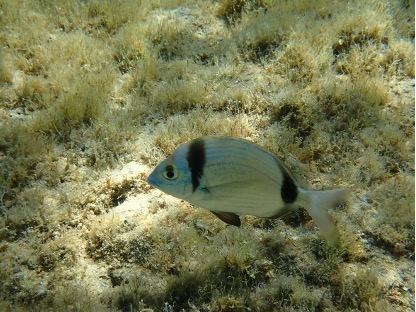
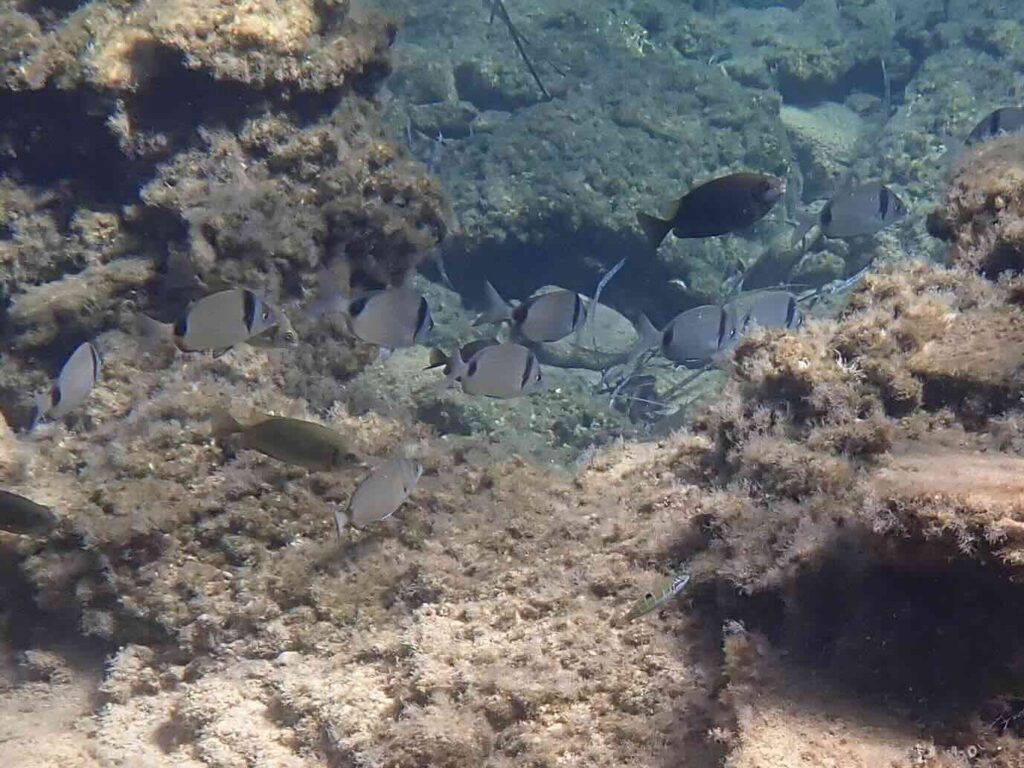
The most common encountered sea breams.
Easy to recognise : 2 wide black bands, one at the head, in front of the pectoral fins and the other in front of the caudal fin. (appear in adulthood, around 4-5 cm long). Fine horizontal stripes (not very marked) on the sides. Yellowish pelvic fins. (adults-length: 15-30 cm, max 45 cm).
Shallow depth (rarely more than 50 m), rocky bottoms, overhangs, seagrass beds, usually in small mixed species schools (e.g., with the common sea bream D. sargus or with the saupe S. salpa).
Reproduction. Protandrous hermaphrodite. Sexual maturity at 2 years of age. Reproduction occurs in autumn, pelagic eggs and juveniles, with winter recruitment. Juveniles live in seagrass beds and shallow rocky bottoms (1 or 3 m). They are initially silvery-grey, the black
bands appear as soon as they reach 2-4 cm.
Geographic distribution. Mediterranean, Black Sea, Eastern Atlantic, (from the Bay of Biscay to Senegal, Cape Verde and Canary Islands).
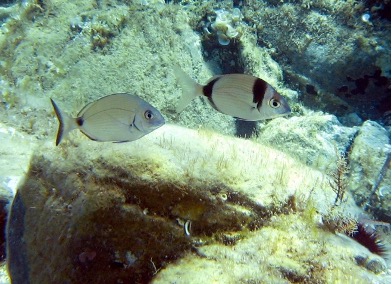
Swimming together, the common white sea bream and the two banded bream, Diplodus vulgaris
The common white sea bream or sargo, Diplodus sargus (Linnaeus, 1758)
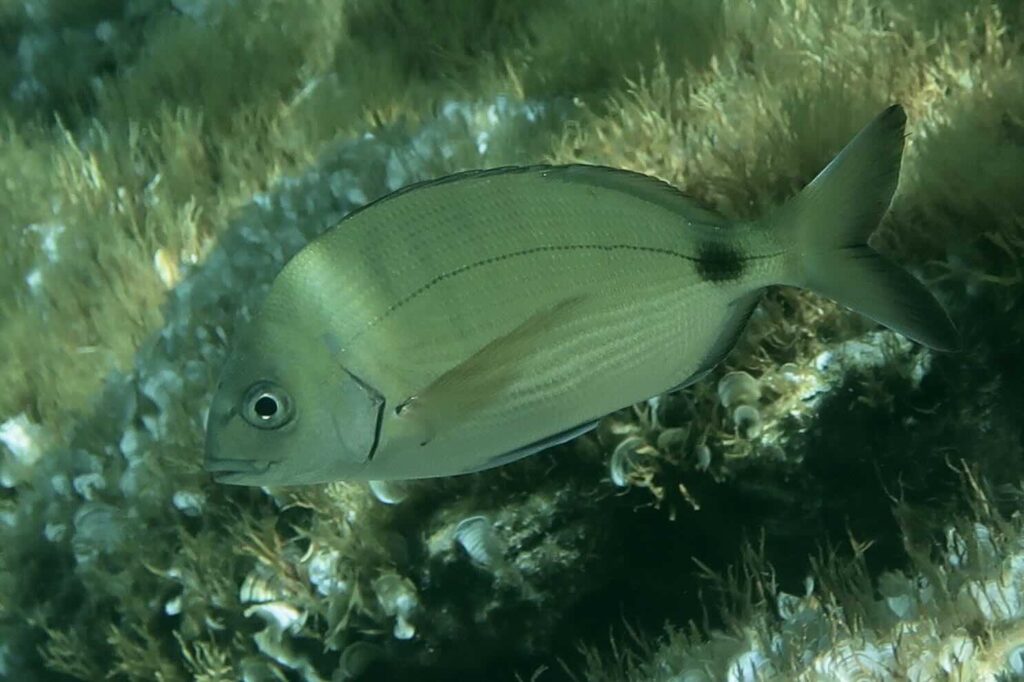
Adults (size: 25-30 cm) are uniformly light silvery-grey, caudal fin edged with black and black spot at its base (sometimes saddle-shaped). Opercula edged with black. Dark spot behind the base of the pectoral fins. Found on rocky bottoms and seagrass beds (1 – 30 m depth). Adults migrate to depth in winter to find more stable and warm temperatures.

Juveniles have 7 to 9 dark brown-grey vertical stripes that fade and disappear in adults.

Reproduction. The common sea bream is first male then female (protandrous fish). Sexual maturity is reached at the age of 2 years, the change of sex occurs after about 5 years. Some individuals may not change sex. Reproduction occurs at the end of winter (January-March) and the gametes are emitted during gatherings on rocky bottoms. Larvae are planktonic, but juveniles are found at shallow depths on rocky bottoms at the beginning of summer. Summer recruitment.
Geographic distribution. Mediterranean, eastern Atlantic (Strait of Gibraltar, Portugal, Bay of Biscay, Brittany).
The annular sea bream, Diplodus annularis (Linnaeus 1758)
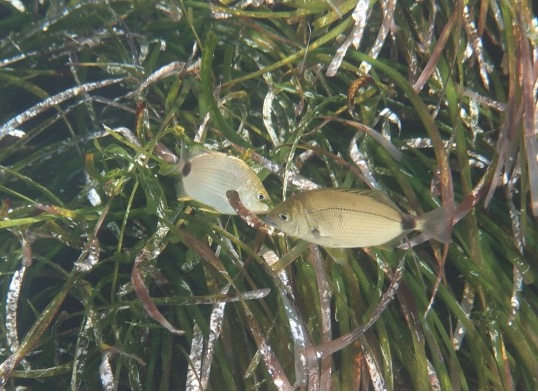
The smallest Mediterranean bream (size: 15-20 cm) (left fish on the picture; it faces a Diplodus sargus)
Silver-yellowish body with yellowish highlights, black spot surrounding the base of the caudal fin in a ring (hence the name ‘annularis’), yellow pelvic fins and beginning of the anal fin. Juvenile colour yellow with a black caudal ring.
Especially found on Posidonia seagrass beds but also on rocky bottoms.
Reproduction. Sexes are separated but there are some cases of protandrous hermaphroditism. Sexual maturity at 1 year. Reproduction occurs from February to April, eggs and larvae (1 month) are planktonic, coastal juveniles are observed in June (summer recruitment).
Geographic distribution. Mediterranean, Black Sea, Eastern Atlantic (from the Bay of Biscay to Gibraltar, Canary Islands, Madeira Islands)
The sharp snout sea bream or sheep head bream or puntazzo, Diplodus puntazzo (Walbaum1792)
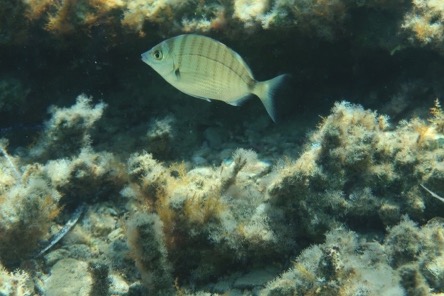
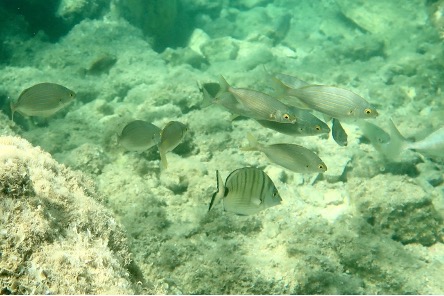
Typical head shape with a ‘pointed snout’. Raised body, silvery grey in colour with about ten dark vertical lines on the sides, fading in adults. Black spot surrounding the base of the caudal fin. Black spot at the base of the pectoral fins. Caudal fin edged with black. (usual length of adults: 15-40 cm).
Rocky bottoms, crevices, rather dark places (living up to a maximum depth of 150 m); adults often solitary or in small schools with other sea breams or salema (photo).
Reproduction. It is a protandrous hermaphrodite fish (male become female during their life span). Reproduction occurs from August to September; juveniles arrive on the coastal rocky bottoms between October and December (winter recruitment).
Geographic distribution. Mediterranean, Black Sea, Eastern Atlantic (from the Bay of Biscay to Sierra Leone)
2. The saupe (or salema), Sarpa salpa (Linnaeus, 1758) – Sparidae

Saupes are regularly named ‘sea cows’. Indeed, they are vegetarians and assiduously 'graze' on algae (green, red and brown) and on Posidonia leaves in seagrass beds (see pictures). They are initially carnivorous (prey = small crustaceans) then, as they grow, gradually become vegetarians.
Toxins from algae can cause food poisoning with hallucinatory syndromes (= ichthyosarcotoxism). This toxicity would be periodic, appearing when the fishes feed intensely on algae and on seagrasses.

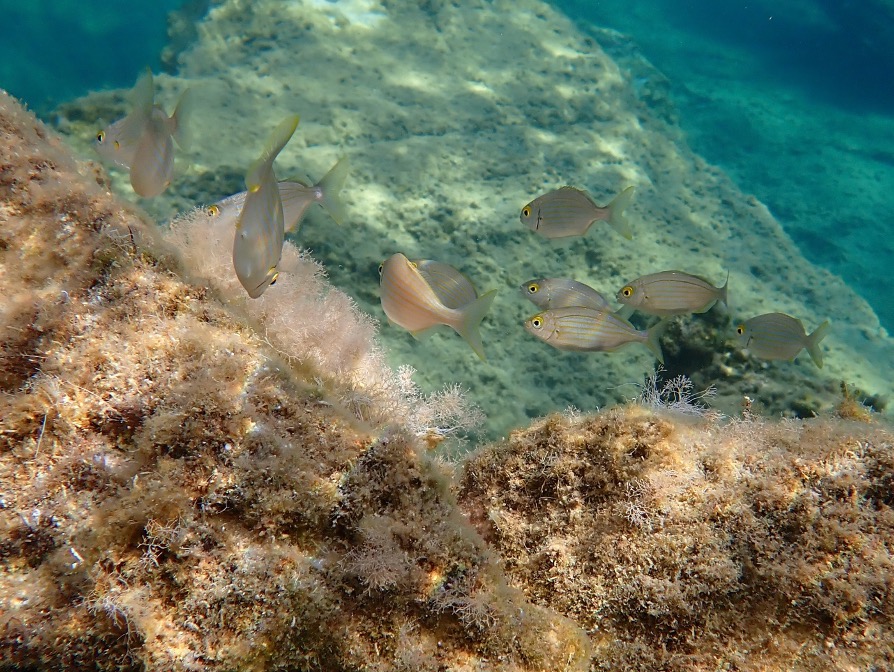
The body is oval, laterally compressed, silver-gray in color, with on the flanks (from head to tail) 10 to 12 bright yellow longitudinal lines and a small blackish spot at the base of the pectorals. Eyes are yellow, close to the mouth which has protruding teeth. Adults measure 20 to 35 cm long (exceptionally 50 cm).
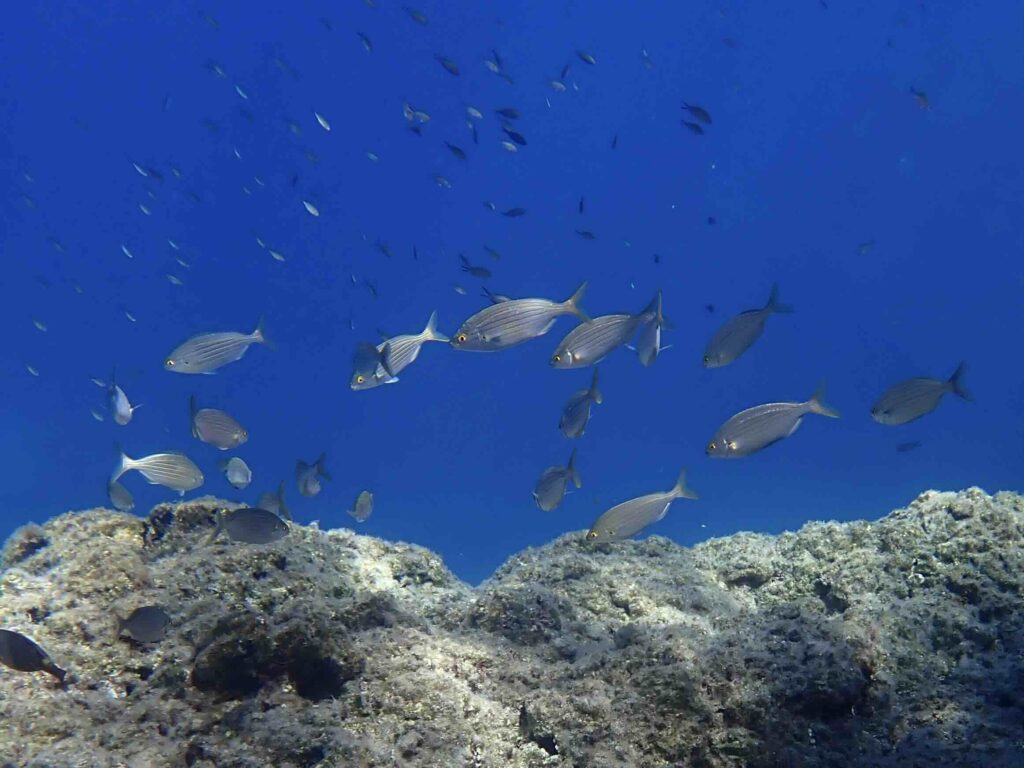

This fish lives in schools sometimes made up of several dozen individuals, in the first 20 m of depth. The schools include adults of different sizes, the large individuals are females, the small ones, males.
Reproduction. It is a protandrous fish, first male then female. Males reach sexual maturity in their 3rd year (size ca. 21 cm) and become females during the 4th year (size ca. 26-28 cm). Breeding takes place from spring up to fall and eggs are laid in open water. The young live at shallow depths on rocky bottoms and seagrass beds.


Geographical distribution. Mediterranean, Eastern Atlantic (Bay of Biscay and Strait of Gibraltar, and islands of Madeira, Canary Islands, Cape Verde).
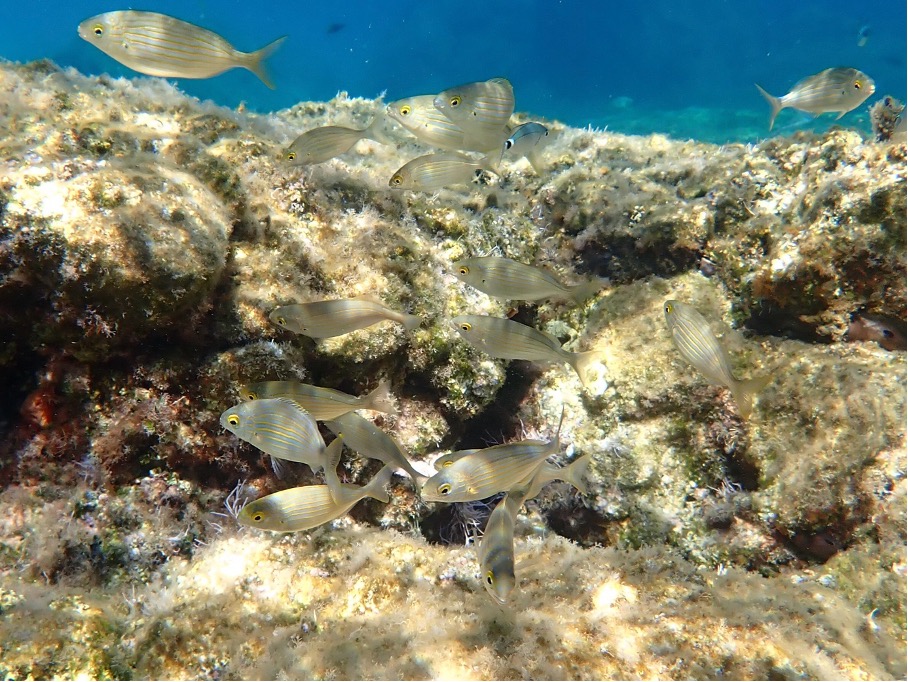
3. Rabbitfish, Siganus luridus and Siganus rivulatus – Siganidae
These two rabbitfish species are common in the waters of Antiparos. They are invasive species, originating from the eastern coasts of the Indian Ocean (east coast of Africa, Comores, Madagascar, Seychelles) and arriving in the Mediterranean via the Red Sea and the Suez Canal (Lessepsian invasive species).
The two species often occur together in mixed schools, which also include some other species such as salema and sea bream. They are uneasy to distinguish! Their most simple characteristics observable for freedivers are (1) the shape of the caudal fin, truncated in S. luridus and forked in S. rivulatus and, (2) the body shape, rather stocky in S. luridus and more fusiform and elongated in S. rivulatus. Body color is not a reliable criterion as it varies. S. luridus is particularly striking because its color change occurs in a matter of seconds (see species description).
Siganidae possess sharp spines on their fins. These spines serve a defensive purpose. They are venomous, each connected to two venom glands. When threatened, the fish spreads its fins, raising its rays, becoming a « ball of venomous pins. »
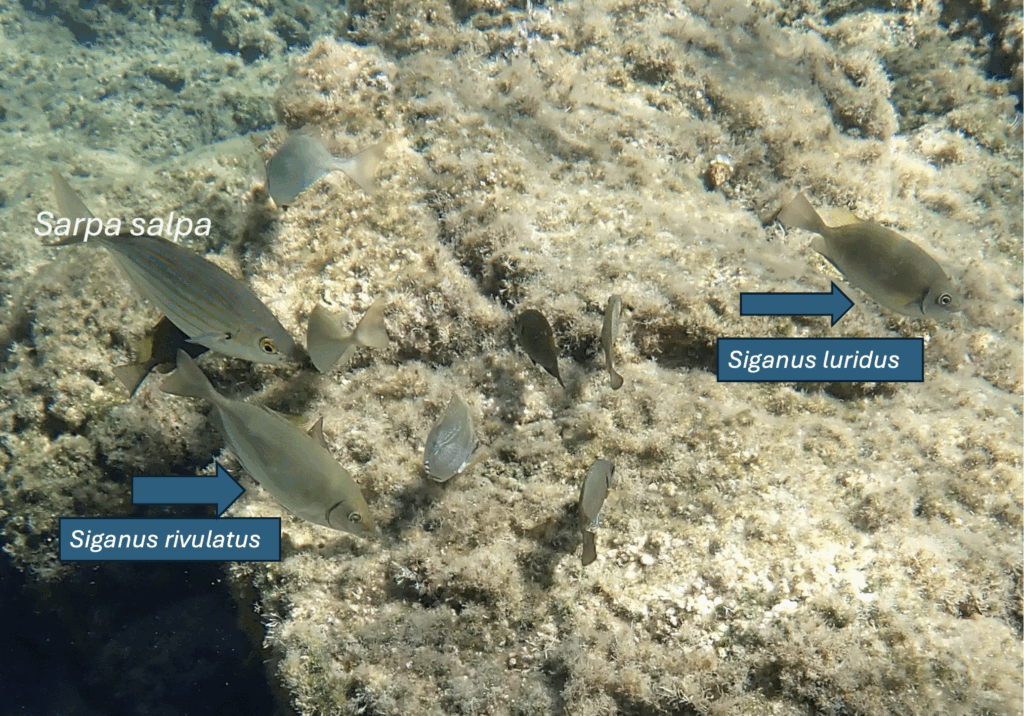
3.1. The squaretail rabbitfish, Siganus luridus (Rüppell, 1829)
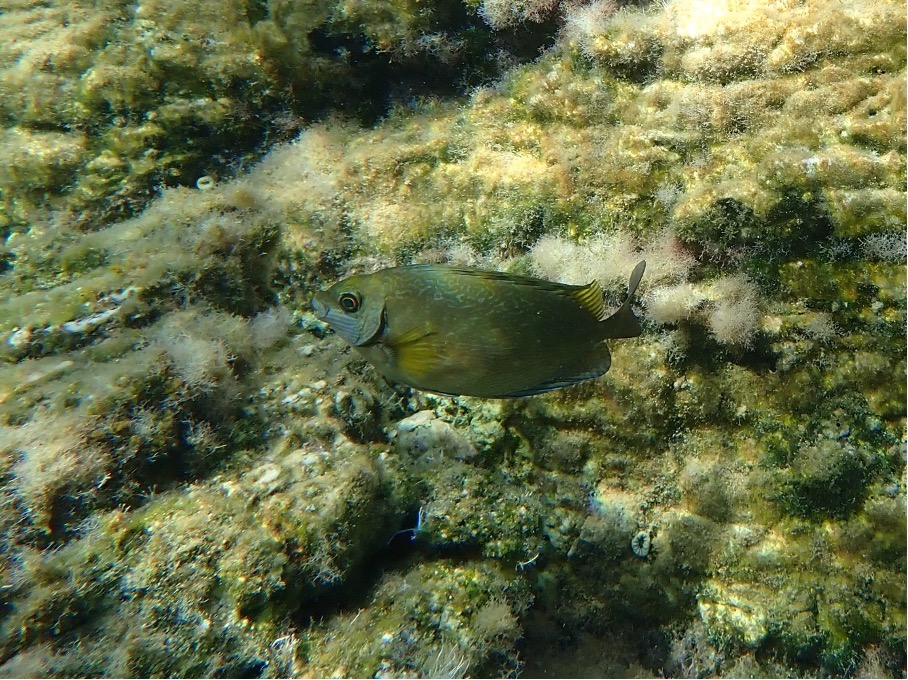
This is an invading species that originates from the Western Indian Ocean and the Red Sea. It entered the Mediterranean waters via the Suez Canal (‘Lessepsian’ species), spreading throughout the Mediterranean over the last 20 years. Several features favor its dispersal: adults are good swimmers, opportunistic for habitat and food, and larvae can be dispersed over long distances (ca. 1000 km).
Found up to 40 meters deep on rocky bottoms and seagrass beds, it competes for food and habitats with native fish species. Siganus luridus is herbivorous, feeding on several species of algae (especially brown algae) and on seagrasses. It occasionally ingests small animals.
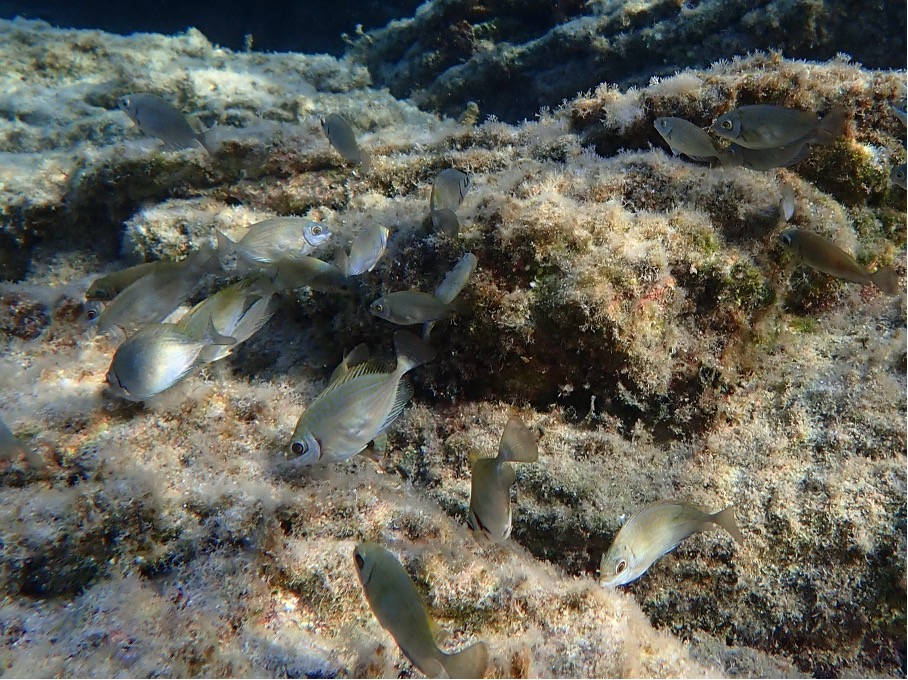
Adults (ca. 20-25 cm in length) are characterised by the straight end of the caudal fin, a body strongly compressed laterally and by almost symmetrical dorsal and anal fins (hence the rectangular appearance of the back of the body). The head is small, with large, rather dorsal eyes, with a small mouth lined with prominent lips (labial folds) and with a discreet, flattened growth near the nostril.
Typically, they can rapidly change color, displaying three main patterns: (1) body uniformly yellow, pale brown or bronze, (2) whole body greenish to bronze with irregular fine horizontal or convoluted stripes, alternating dark and light, the head then with a darker upper part and horizontal striped cheeks, (3) body with two wide dorsal brownish bands (mottled or uniform) and a yellowish belly. At night, as well as under stress, whole body may turn completely mottled with brown patches.

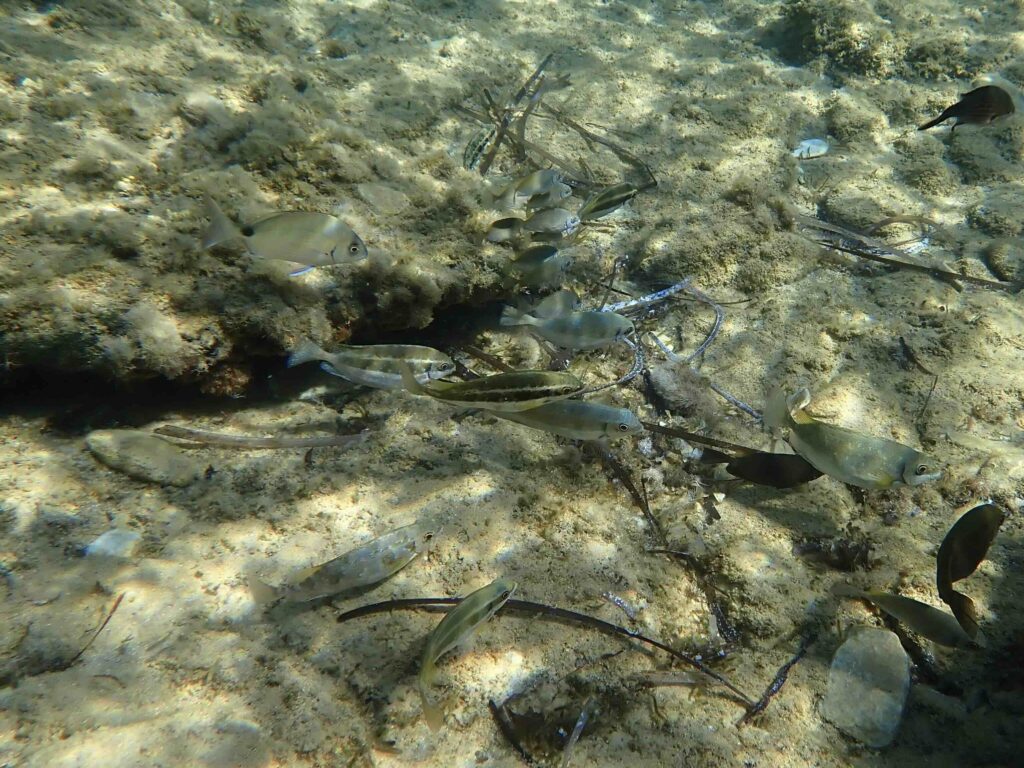

Reproduction: late May to September; external fertilisation; the eggs fall to the bottom and hatch 26 to 32 hours later. The larvae rise to the surface and feed on plankton for 3-4 days before going back to the bottom. The juveniles form large schools, observable in May at shallow depths (2-4 m).
It is not an aggressive fish, but when stressed it can suddenly straighten its dorsal fin venomous spines and discourages predators (painful stings)!
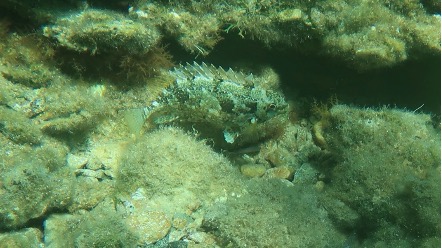
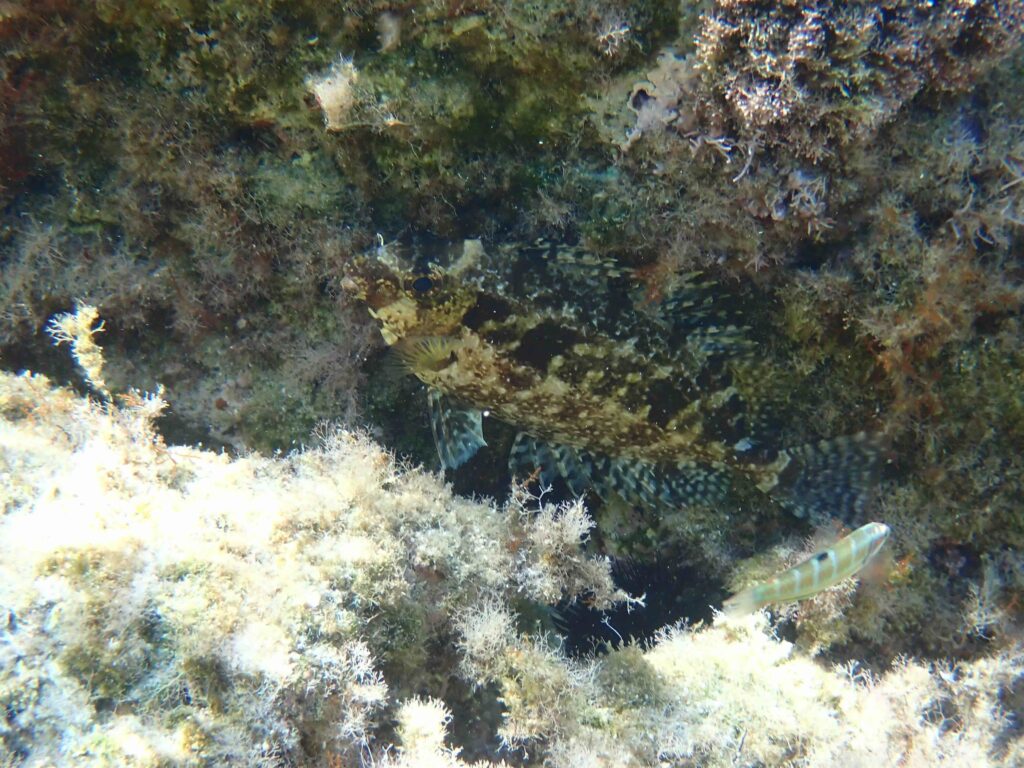
3.2. The rabbitfish, Siganus rivulatus (Forsskål & Niebuhr, 1775)
Siganus rivulatus has a fusiform, elongated body (ca. 20-25 cm long), with a rather pointed snout, a small terminal mouth, and a forked tail. Its color is generally light (beige, grayish) with fine, irregular yellow lines on its flanks, particularly ventrally. Like S. luridus, its fins bear venomous spines.
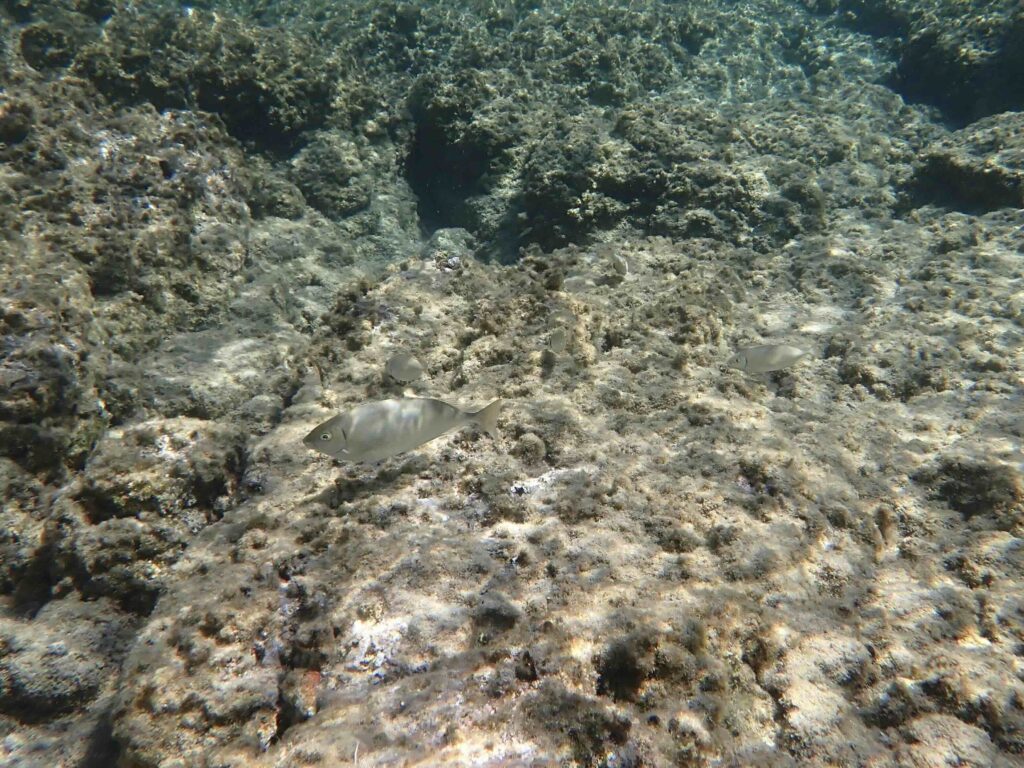

Note: I have never seen it changing color instantly like S. luridus. However, this change is reported by some authors. (https://www.fishipedia.fr/fr/poissons/siganus-rivulatus).
This invasive species is increasingly abundant, voracious, and competing for food (algae); it often forms mixed schools, particularly with S. luridus and Sarpa salpa. It is an oviparous fish, reproduction generally takes place from late May to mid-July; the eggs are laid in open water, and the hatching larvae are pelagic.